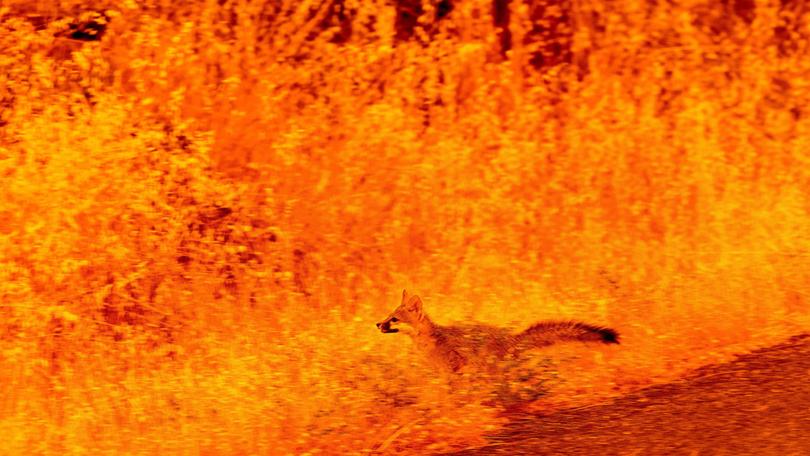North America wildfires: Lightning and a burning car blamed for wildfires scorching the US and Canada’s west

A man has been charged with starting California’s largest wildfire of the year while a fast-moving blaze that ravaged Canada for the last week destroyed a Rocky Mountain resort town.
North America’s wildfire crisis has continued apace thanks to high temperatures, dry conditions and lightning storms which have been plaguing much of the continent’s west this month, causing numerous blazes, including in the Western Canadian provinces of British Columbia and Alberta, which lost the tourist town of Jasper overnight.
Meanwhile in California a conflagration that has prompted evacuations and threatened the state’s power grid has led to the arrest of a 42-year-old man, suspected of pushing a burning car into a gully before the Park Fire erupted Wednesday, the Butte County district attorney’s office said in a statement.
Sign up to The Nightly's newsletters.
Get the first look at the digital newspaper, curated daily stories and breaking headlines delivered to your inbox.
By continuing you agree to our Terms and Privacy Policy.The fast-moving fire, located about 140km north of Sacramento, has already spread to more than 28,900 hectares and is only 3 per cent contained, according to the California Department of Forestry and Fire Protection.
The blaze forced California’s main electrical grid operator to warn of potential power shortages Wednesday evening, saying the fire could disrupt imports into the state. The wildfire had disabled two high-voltage transmission lines in the area owned by PG&E Corp., according to a spokeswoman for the utility. The California Independent System Operator lifted the warning on Thursday and said the grid was stable, according to a spokeswoman.
The wildfire has created a “dangerous situation” as it spreads quickly through the rural area, Daniel Swain, a climatologist at the University of California, Los Angeles said in an X post.
The incident is the latest major blaze in California as the state nears the heart of wildfire season. California has had two winters of plentiful rain and snow that encouraged vast amounts of vegetation to spring up, leaving plenty of fuel to ignite during the driest time of the year.
As evacuations continued in California, some Oregon residents were cleared to return home after a thunderstorm dropped welcome rain but also potentially dangerous lightning on the biggest active blaze in the United States. More than two dozen new fires started in Montana on Wednesday and early Thursday.
In eastern Oregon, evacuation orders were lifted Thursday for the city of Huntington, population 500, after a severe thunderstorm late Wednesday brought some rain and cooler temperatures to the nearly 1,630 square kilometres burned by the Durkee Fire – the nation’s biggest – and another nearby blaze.
Baker County Sheriff Travis Ash called the rain a “godsend” and the Oregon State Fire Marshal said firefighters were set to “seize the opportunity” of better conditions to push back the fire on the Oregon-Idaho border that remained unpredictable and just 20 per cent contained, according to the government website InciWeb.
Lightning strikes along the Oregon-Idaho border started 15 new fires overnight in Idaho, the U.S. Forest Service told Boise’s KBOI-TV, but several had already been extinguished by Thursday afternoon. More than 2,800 cloud-to-ground lightning strikes were detected across southeast Oregon and Idaho on Wednesday alone, the National Weather Service in Boise said Thursday.
Overall, nearly 4045 square kilometres have burned so far this summer in the Pacific Northwest. Oregon alone has 34 large fires, almost all of them in the central or eastern part of the state.
Climate change is increasing the frequency of wildfires sparked by lightning across the Pacific Northwest and western Canada as the region endures recording-breaking heat, with many triple-digit days and bone-dry conditions. Idaho Power has for the first time instituted a pre-emptive power outage, shutting off electricity to thousands of customers to prevent new fire starts and other power grid issues from wires downed by the high winds, the utility said.
In Montana, a fire warning was in effect in the central part of the state due to high temperatures, low humidity and strong winds. An extreme heat warning east of the storm front meant temperatures could soar up to 108 degrees Fahrenheit 42 degrees Celsius. After hurricane-force winds toppled trees, downed power lines and damaged gas lines in the Missoula area, authorities urged people to stay out of rivers because they might be electrified.
In the Canadian Rockies’ Jasper National Park, locals were still taking stock of the damage in Jasper.
“The wildfire is still out of control and crews are working in dangerous conditions to try and protect critical infrastructure in the town,” Alberta Premier Danielle Smith said Thursday. “We share a loss with all of those who live in the town, who care for it and who have helped build it.”
The town of 4100 residents is a prime tourist spot, given its location in the heart of a huge national park in the Canadian Rockies.
“Multiple structures, including a number of businesses and homes, in and around the Town of Jasper have been lost,” Parks Canada said.
